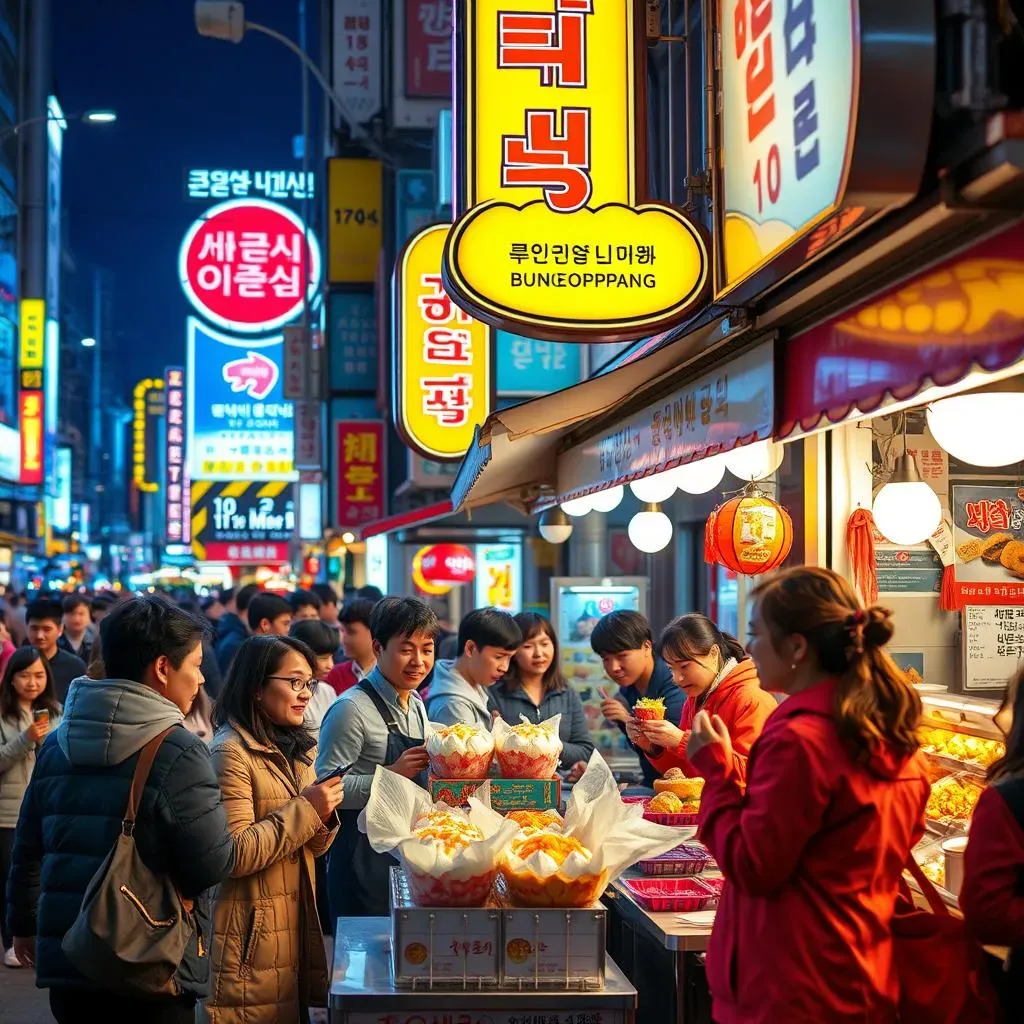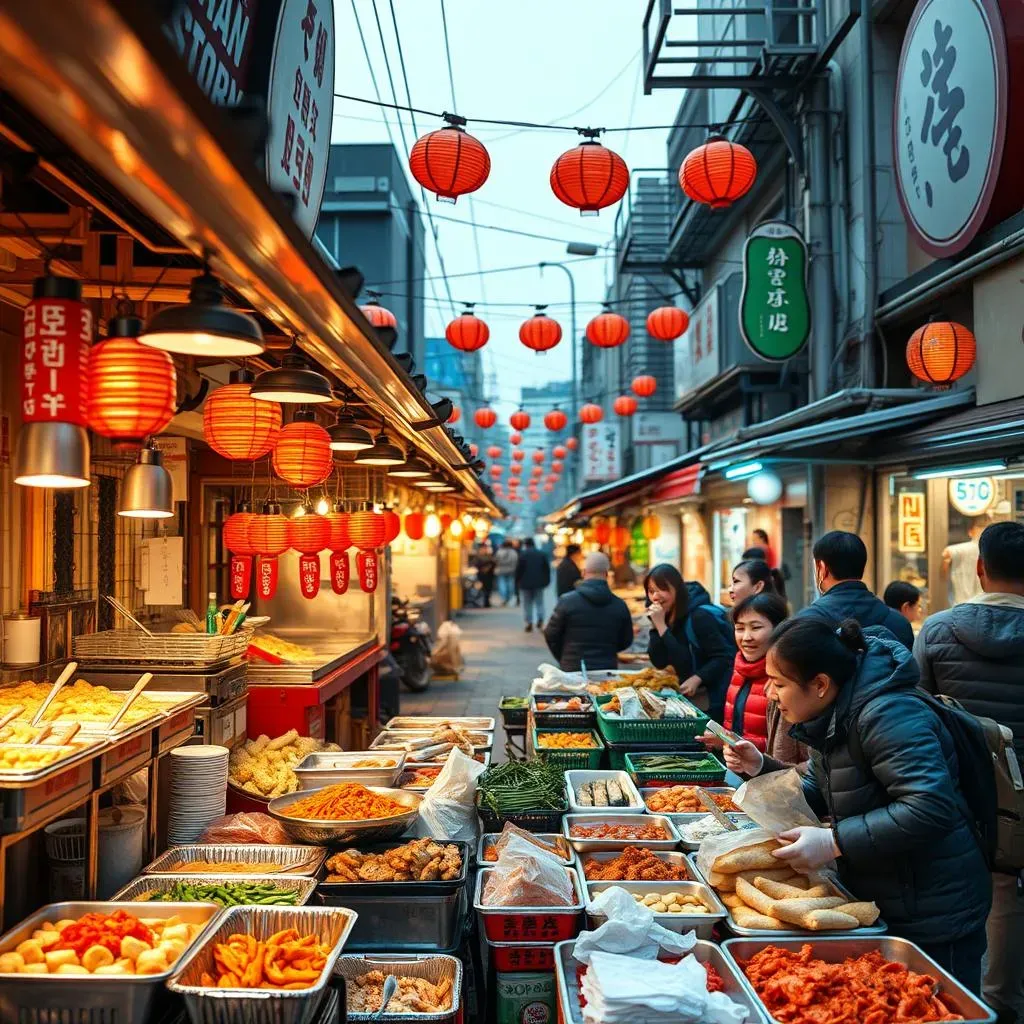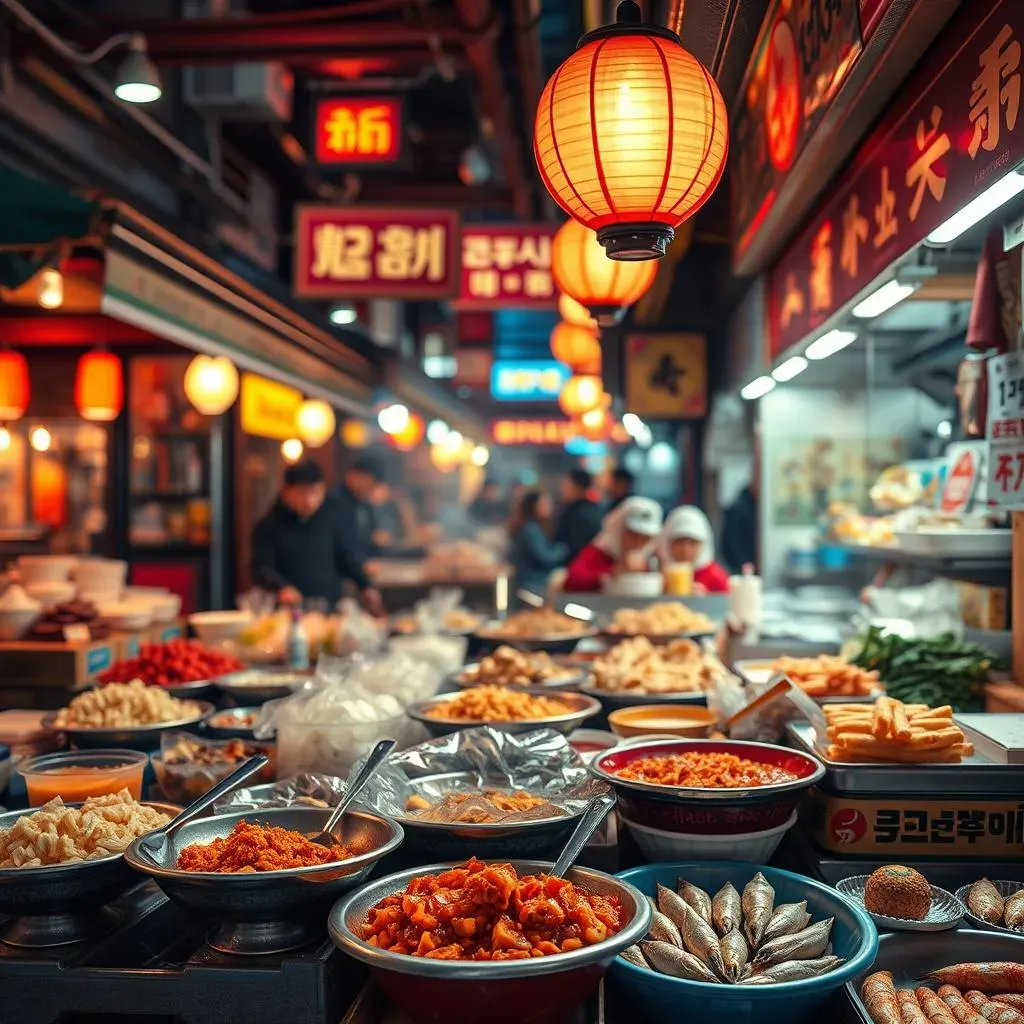Table of Contents
Get ready for a culinary adventure! South Korea isn't just known for its K-pop and cutting-edge technology; it boasts a vibrant street food scene that's bursting with flavor and excitement. This article is your passport to discovering the incredible world of famous street food in South Korea. We'll journey through a diverse range of savory and sweet treats, from the fiery kick of tteokbokki to the comforting sweetness of hotteok. You'll learn about the rich history and cultural significance behind these iconic dishes, understanding why they're so beloved by both locals and tourists. We'll also equip you with insider tips on where to find the best street food vendors in major cities like Seoul and Busan, ensuring your taste buds experience the ultimate Korean street food extravaganza. Prepare to be amazed by the variety, affordability, and sheer deliciousness of the famous street food in South Korea – your mouth will thank you!
Savory Sensations: MustTry Famous Street Food in South Korea
Savory Sensations: MustTry Famous Street Food in South Korea
Spicy Delights: Tteokbokki and Beyond
Let's start with the undisputed queen of Korean street food: tteokbokki. These chewy rice cakes swim in a vibrant, spicy sauce that's both addictive and unforgettable. The level of spice can vary wildly, so beginners should start cautiously. You'll find countless variations, from the classic gochujang-based sauce to more creative options like cheese or curry tteokbokki. It's a truly versatile dish that perfectly encapsulates the bold flavors of Korean cuisine. Want to learn more about the history of this iconic dish? Check out our article on Korean street food history for a deeper dive.
Beyond the tteokbokki, a whole world of savory snacks awaits. Think crispy, golden-brown twigim (deep-fried goodies) – everything from vegetables to seafood gets the deep-fry treatment. Or perhaps you're in the mood for mandu, delicious dumplings filled with savory meat and vegetables. These can be steamed, boiled, pan-fried, or even deep-fried, each method offering a unique textural experience. For more dumpling inspiration, check out our guide to Korean street food recipes!
Dish | Description | Spice Level |
|---|---|---|
Tteokbokki | Chewy rice cakes in spicy sauce | Mild to Very Spicy |
Twigim | Deep-fried snacks (various fillings) | Generally Mild |
Mandu | Savory meat and vegetable dumplings | Mild |
From the Sea: Seafood Sensations
Korea's coastal location means fresh seafood is abundant, and this is reflected in the amazing street food on offer. Eomuk (fish cakes) are a perennial favorite, often served on skewers and simmered in a flavorful broth. The broth itself is often a culinary masterpiece, providing a comforting warmth on a chilly day. These are incredibly affordable and perfect for a quick bite. For a more substantial meal, consider hotteok, a sweet pancake often filled with brown sugar, cinnamon, and nuts. But don't let the sweetness fool you – there are plenty of savory options available, too!
Looking for something a bit more adventurous? Then you might want to try some grilled seafood – skewers of squid or other delicacies are common sights at bustling markets. The aroma alone is enough to make your mouth water. These grilled options often come with a simple seasoning, letting the natural flavors of the seafood shine through. The best part? You can often find these amazing treats at incredibly reasonable prices. For more amazing street food finds, check out our post on Korean famous street food.
- Eomuk (fish cakes): Often served on skewers in broth.
- Grilled Seafood: Squid, shrimp, and other delights.
- Hotteok: Sweet pancakes (savory variations exist).
Meat Lovers' Paradise: Dakgangjeong and More
If you're a meat lover, South Korea's street food scene won't disappoint. Dakgangjeong (Korean fried chicken) is a must-try. This isn't your average fried chicken; it's a crispy, flavorful masterpiece, often coated in a sweet and spicy sauce that's both addictive and irresistible. The crunch is phenomenal, and the flavor is perfectly balanced between sweet and spicy. It's a classic for a reason!
Beyond the chicken, you'll find an array of other meaty delights. From grilled meats on skewers to savory pancakes with meat fillings, the options are seemingly endless. Many dishes incorporate marinated meats, adding another layer of complexity and flavor. The quality of the meat is typically very high, even from street vendors, ensuring a satisfying culinary experience. To see more pictures of delicious Korean street food, check out our gallery on Korean street food in Orlando.
Sweet Treats and Unique Delights: Exploring South Korea's Famous Street Food Scene
Sweet Treats and Unique Delights: Exploring South Korea's Famous Street Food Scene
Sugary Sensations: Hotteok and More
Let's talk sweet! Hotteok, those irresistible sweet pancakes, are a must-try. Imagine warm, chewy dough filled with a gooey mixture of brown sugar, cinnamon, and nuts. It's a perfect blend of textures and flavors, a comforting treat that's perfect for a chilly evening. You'll find variations with different fillings, too – some vendors get really creative! For more delicious dessert ideas, check out our guide to Korean street food desserts.
Beyond hotteok, there's a whole world of sweet street food to discover. Bungeoppang, fish-shaped pastries filled with sweet red bean paste, are another classic. These are especially popular during colder months, offering a warm and comforting treat. And let's not forget Gyeranppang, egg bread – a fluffy pancake with a whole egg baked inside. It's a simple yet satisfying combination of sweet and savory flavors.
- Hotteok: Sweet pancakes with various fillings.
- Bungeoppang: Fish-shaped pastries with red bean paste.
- Gyeranppang: Fluffy pancake with a whole egg inside.
Unique and Unexpected: Exploring Korean Sweet Treats
But the sweetness doesn't stop there! Korea offers a range of unique and unexpected sweet treats. Think Dalgona, that mesmerizing honeycomb candy that's both fun to make and delicious to eat. It's a childhood favorite for many Koreans and a great conversation starter. Or maybe you'd prefer kkochi – skewers aren't just for savory dishes. Many vendors offer sweet variations, often featuring fruit or marshmallows.
Don't be afraid to experiment! Korean street food vendors are often happy to explain their creations, and trying something new is part of the fun. You might discover your new favorite sweet treat. And remember, many sweet snacks are also perfect for pairing with drinks – the perfect end to a day of exploring. To discover more unique street food options, check out our article on JMT Korean street food.
Dish | Description | Sweetness Level |
|---|---|---|
Dalgona | Honeycomb candy | Very Sweet |
Kkochi (sweet) | Sweet skewers (fruit, marshmallows, etc.) | Varies |
Various other sweets | Many other sweet treats available! | Varies |
Beyond the Basics: Finding Hidden Gems
While the classics are always a good choice, don't be afraid to venture beyond the well-trodden path. Many smaller vendors offer unique and creative sweet treats that you won't find anywhere else. Keep your eyes peeled for unusual flavors and combinations – you might just stumble upon your new favorite dessert! Ask around – locals are always happy to share their recommendations.
Remember, the best part of exploring Korean street food is the experience itself. The vibrant atmosphere, the friendly vendors, and the sheer delight of discovering new flavors all contribute to a memorable culinary adventure. So embrace the unexpected, and you'll find yourself rewarded with some truly unforgettable sweet treats. For more information on finding unique street food, check out our Korean street food vendors guide.
Beyond the Bites: Culture and History of Famous Street Food in South Korea
Beyond the Bites: Culture and History of Famous Street Food in South Korea
A Culinary Timeline: From Humble Beginnings to Global Craze
Korean street food isn't just about deliciousness; it's a fascinating reflection of the country's history and culture. Think of tteokbokki—that spicy rice cake dish we all love. Its origins trace back centuries, evolving from a simple peasant food to a national obsession. Its journey mirrors Korea's own transformation, evolving alongside its society and reflecting changing tastes and trends. Want to learn more about the fascinating evolution of this dish? Check out our article on Korean street food history.
Many other dishes tell similar stories. Mandu, those savory dumplings, have roots in ancient Asian cuisine, adapting and evolving within the Korean context. The ingredients, cooking methods, and even the shapes have changed over time, reflecting Korea's interactions with neighboring countries and its own culinary innovations. For more on this, check out our Korean street food recipes article.
- Tteokbokki: From peasant food to national treasure.
- Mandu: Ancient roots, modern adaptations.
- Many other dishes reflect Korea's rich history.
Street Food and Social Life: More Than Just a Snack
Street food plays a vital role in Korean social life. It's not just about filling your stomach; it's about connecting with friends and family, sharing experiences, and creating memories. Imagine a bustling market, the aroma of sizzling meats and sweet treats filling the air, friends gathered around a vendor, sharing laughter and stories. That's the heart of the street food experience.
Street food vendors are often integral parts of their communities, building relationships with regulars and becoming familiar faces. They're not just selling food; they're creating a sense of belonging and shared experience. This social aspect is often overlooked but is just as important as the food itself. Check out our piece on Korean street food vendors for a closer look.
Aspect | Significance |
|---|---|
Social Interaction | Creates a sense of community and shared experience. |
Cultural Identity | Reflects Korea's history, traditions, and values. |
Economic Impact | Supports local businesses and livelihoods. |
Global Influence and Modern Trends: Street Food's Ever-Evolving Nature
Korean street food's influence extends far beyond its borders. Dishes like kimchi and bibimbap have become global culinary sensations, showcasing Korea's rich culinary heritage to the world. But the scene is constantly evolving, with new trends and creative fusions emerging all the time. This dynamic nature keeps the street food experience fresh and exciting.
Today, you can find everything from traditional classics to modern innovations, often blending Korean flavors with international influences. This fusion reflects Korea's position on the global stage, its open embrace of different cultures, and its willingness to experiment and innovate. For more examples of modern twists on classic dishes, take a look at our article on JMT Korean street food.
Finding Your Feast: Where to Find the Best Famous Street Food in South Korea
Finding Your Feast: Where to Find the Best Famous Street Food in South Korea
Seoul's Street Food Hotspots
Seoul, the vibrant capital, is a street food paradise! Myeongdong is legendary – a bustling shopping district packed with vendors selling everything from spicy tteokbokki to sweet hotteok. Hongdae, known for its youthful energy, offers a different vibe, with pojangmacha (tented stalls) serving up late-night snacks and drinks. Insadong, with its traditional crafts and tea houses, offers a more refined street food experience, often with a cultural twist. For a truly immersive experience, consider a guided Korean street food tour – a knowledgeable local can lead you to hidden gems and explain the cultural significance of each dish.
Beyond these iconic areas, explore smaller neighborhoods and local markets. Each district has its own unique culinary character, offering a chance to discover hidden gems and local favorites. Don't be afraid to wander off the beaten path – you might stumble upon a tiny stall serving up the best tteokbokki you've ever tasted! To find street food near you, check out our guide to Korean street food near me.
- Myeongdong: Bustling shopping district with diverse street food.
- Hongdae: Youthful area with pojangmacha (tented stalls).
- Insadong: Cultural district with a more refined street food scene.
Beyond Seoul: Other Cities' Culinary Delights
While Seoul is the undisputed king of Korean street food, other cities offer equally exciting culinary experiences. Busan, a coastal city known for its fresh seafood, boasts its own unique street food scene. Bupyeong Kkangtong Market is a great place to start, famous for its distinctive fish cakes. Jeonju, home to Jeonju Hanok Village, offers a blend of traditional and modern street food, often with a bibimbap theme. For an overview of famous street food across Korea, check out our article on famous Korean street food.
Remember that many markets specialize in certain types of food. Some focus on seafood, others on meat, and still others on sweet treats. Doing a little research beforehand can help you find the perfect market for your taste preferences. And don't forget to check local event calendars – many cities host food festivals and markets throughout the year, offering a chance to sample a wider range of street food delights. For more on where to find specific foods, see our guide on Korean street food locations.
City | Street Food Highlight |
|---|---|
Busan | Fresh seafood, Bupyeong Kkangtong Market |
Jeonju | Bibimbap-themed street food |
Many other cities | Regional specialties await! |
Tips for a Successful Street Food Adventure
To maximize your street food experience, arrive with an empty stomach and a sense of adventure! Don't be afraid to try new things – that's half the fun. Many vendors are happy to explain their dishes, and you can often sample before you buy. Pay attention to the queues – long lines often indicate a popular vendor. And remember to bring some cash, as many vendors don't accept cards. For more tips, check our article on Korean street food vendors.
Finally, embrace the atmosphere! Korean street food is best enjoyed with a sense of fun and exploration. Engage with the vendors, chat with fellow food lovers, and savor the unique flavors and cultural richness of this amazing culinary scene. For inspiration, check out our picture gallery of Korean street food in Orlando.